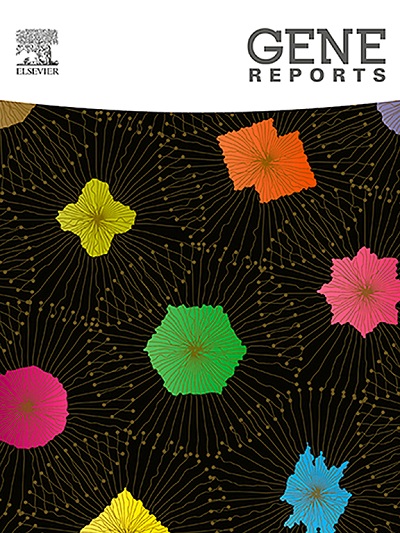Unravelling the interplay of antimicrobial resistance and stress response in the saline desert metagenomes of Gujarat, India
IF 1
Q4 GENETICS & HEREDITY
引用次数: 0
Abstract
The metagenomic analysis of the present study states the intricate community of salt-tolerant bugs living in saline soils from Kutch, Gujarat. Metagenomics sequencing has already been explored in this region for community analysis. However, we analyzed the metagenome of a saline desert and compared it with publicly available published metagenomes to identify common antimicrobial resistance found in the saline desert. The bioinformatics-based analysis revealed the presence of various antibiotic resistance (AMR) genes in Escherichia coli EF-Tu mutants, which confer resistance to several compounds, including Pulvomycin, FosG, rsmA, qacJ, and qacG. Additionally, the vanW gene in the vanI cluster and the vanY gene in the vanM cluster were identified. These mutants exhibit different resistance mechanisms, such as antibiotic inactivation (VanA — VIM-VIA), alteration of antibiotic targets (cfr and VanB), and the involvement of antibiotic efflux pumps, etc. The prevalence of AMR genes related to efflux pump indicates the importance of this genes (copR, bcrA, cesC, merA, narA, tetA, trxLHR and yfeB) toward salt tolerance and antibiotic resistance. This effect was robust even when human impacts were not substantial, illustrating the overwhelming adaptability of these organisms. The variable presence of these genes throughout the samples highlights an environmental effect on their distribution, suggesting a resistance mechanism. This work paves the way to understanding antimicrobial resistance genes produced in these pristine, human-untouched places.
揭示了印度古吉拉特邦盐碱化沙漠宏基因组中抗菌素耐药性和应激反应的相互作用
本研究的宏基因组分析表明,生活在古吉拉特邦库奇盐碱地中的耐盐细菌的复杂群落。宏基因组测序已经在该地区进行了群落分析。然而,我们分析了盐碱地沙漠的宏基因组,并将其与公开发表的宏基因组进行了比较,以确定盐碱地沙漠中发现的常见抗菌素耐药性。基于生物信息学的分析显示,大肠埃希菌EF-Tu突变体中存在多种抗生素耐药性(AMR)基因,这些基因赋予了对几种化合物的耐药性,包括普氏霉素、FosG、rsmA、qacJ和qacG。此外,还鉴定了vanI簇中的vanW基因和vanM簇中的vanY基因。这些突变体表现出不同的耐药机制,如抗生素失活(VanA - VIM-VIA)、抗生素靶点改变(cfr和VanB)以及抗生素外排泵的参与等。与外排泵相关的AMR基因的流行表明,这些基因(copR、bcrA、cesC、merA、narA、tetA、trxLHR和yfeB)对盐耐受性和抗生素耐药性具有重要意义。即使在人类影响不大的情况下,这种效应也很强劲,说明这些生物具有极强的适应性。这些基因在整个样本中的可变存在突出了环境对其分布的影响,表明存在抗性机制。这项工作为了解这些原始的、人类未接触过的地方产生的抗微生物药物耐药性基因铺平了道路。
本文章由计算机程序翻译,如有差异,请以英文原文为准。
求助全文
约1分钟内获得全文
求助全文
来源期刊

Gene Reports
Biochemistry, Genetics and Molecular Biology-Genetics
CiteScore
3.30
自引率
7.70%
发文量
246
审稿时长
49 days
期刊介绍:
Gene Reports publishes papers that focus on the regulation, expression, function and evolution of genes in all biological contexts, including all prokaryotic and eukaryotic organisms, as well as viruses. Gene Reports strives to be a very diverse journal and topics in all fields will be considered for publication. Although not limited to the following, some general topics include: DNA Organization, Replication & Evolution -Focus on genomic DNA (chromosomal organization, comparative genomics, DNA replication, DNA repair, mobile DNA, mitochondrial DNA, chloroplast DNA). Expression & Function - Focus on functional RNAs (microRNAs, tRNAs, rRNAs, mRNA splicing, alternative polyadenylation) Regulation - Focus on processes that mediate gene-read out (epigenetics, chromatin, histone code, transcription, translation, protein degradation). Cell Signaling - Focus on mechanisms that control information flow into the nucleus to control gene expression (kinase and phosphatase pathways controlled by extra-cellular ligands, Wnt, Notch, TGFbeta/BMPs, FGFs, IGFs etc.) Profiling of gene expression and genetic variation - Focus on high throughput approaches (e.g., DeepSeq, ChIP-Seq, Affymetrix microarrays, proteomics) that define gene regulatory circuitry, molecular pathways and protein/protein networks. Genetics - Focus on development in model organisms (e.g., mouse, frog, fruit fly, worm), human genetic variation, population genetics, as well as agricultural and veterinary genetics. Molecular Pathology & Regenerative Medicine - Focus on the deregulation of molecular processes in human diseases and mechanisms supporting regeneration of tissues through pluripotent or multipotent stem cells.
 求助内容:
求助内容: 应助结果提醒方式:
应助结果提醒方式:


